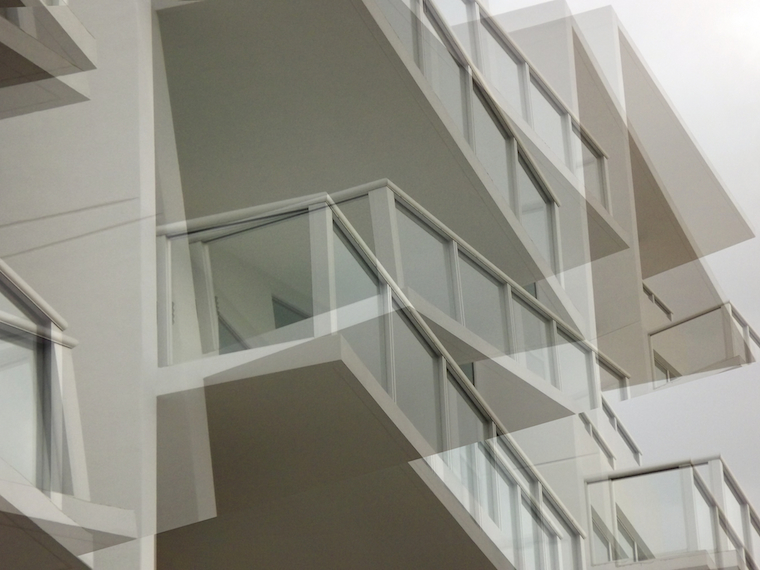
Two exhibits attempt to define what shapes our space
Perceptions of modern-day life, and the blurring of dimensions, tie two shows of new works from two local women artists in fascinating ways. Although Felecia Chizuko Carlisle deals in cold, hard edges and angles, and Michelle Weinberg has a much more decorative aesthetic, their shows currently up in the sprawling Dorsch gallery space, speak to each other, through distorted dimensions and off-kilter perception, however subtly: “Facade” and “The Pretend Dimension” co-exist very well.
Carlisle’s sculptures are the first ones you encounter, in the entry and the project room behind. These geometric pieces of squares and rectangles, shiny and reflective in cold blues and grays, are a direct reference to our urban Miami existence. They are corners and parts of facades of our newest high-rises and skyscrapers, but viewed from the street level. One sculpture appropriately takes over a corner intersection of two walls, emphasizing those particular angles. One piece is laid out across a table, resembling a blueprint or model for one of these humongous edifices that have taken over the city core. As many will remember, back in the heyday of the building boom in the mid-2000s, almost every block in the area had a make-shift building housing such a “maquette” of the latest thing to spring from that ground.
But the centerpiece of Carlisle’s show is the sculpture with projected image which stands alone in the Project Room. It is with this off-white and gray piece, where the geometric elements overlap and reflect off each other, with beautiful shadow-play all around, that one can really understand the artist’s exploration of these steel and glass buildings that have come to define us. Once again, the somewhat skewed perception comes from the idea that we are looking up — way up — at this space, from down on the street. But there is also a sound element here. What, asks the artist, do the acoustic vibrations from these cold materials sound like, bouncing back and forth, up and down? It reflects a broader post-modern world in general, she suggests.
She writes: “Their orderliness has an imposing rhythm and recalls the inhumanity of certain forms of electronic music or experimental noise. They are patterns of constancy anchored deeply into the landscape; yet feel as if at any moment they could float away, leaving behind them the possibility of a new kind of architecture.”
Michelle Weinberg also delves into angles and architecture, and particular perceptions of our every-day life. Her bright, sometimes psychedelic-colored works on paper can look like a mock-up for a new condo, or a set for a movie. You can discern the furniture, the lamps (the lamps are often a focal point) within the more abstracted geometric painting. But these forms are not precise or grid-like in true mathematical proportions, which is why here, again, the perception is a little disorienting.
Like Carlisle, the centerpiece stands alone in a separate room, an installation that includes two-toned painting, found objects and a rug, all covered in the same color and patterns. Anyone familiar with Weinberg’s art will recognize some of the play going on here. She in fact is a rug designer, but as they are not machine-made, they have imperfections that add to the delicacy of them. In this case, the irregularly sided rug changes on many levels depending on where you stand to view it. Next to it are found household items, all painted in a similar pattern. What is fascinating is that, in our ultra-commercialized culture, we can recognize these products no matter the disguise — that’s distinctly a milk carton, a bathroom cleaner, a shampoo bottle. The overall effect, as the gallery notes describe, dissolves “two-and-three-dimensional objects into vibrating mirages.”
“Facade” and “the Pretend Dimension” run through June 9 at the Dorsch Gallery, 151 NW 24th St, Miami; 305-576-1278; dorschgallery.com
Recent Content
-
Artsarticle ·
-
Artsarticle ·
-
Artsarticle ·

